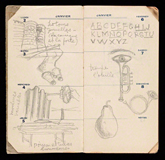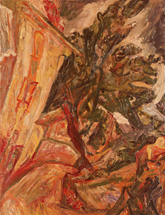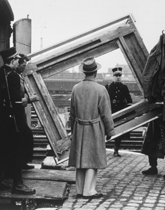A N N O U N C E M E N T
| |
 Spread from Man Ray's datebook, 1939. The Getty Research Institute, 2011.M.17 © 2011 Man Ray Trust / Artists Rights Society (ARS), NY / ADAGP, Paris
Spread from Man Ray's datebook, 1939. The Getty Research Institute, 2011.M.17 © 2011 Man Ray Trust / Artists Rights Society (ARS), NY / ADAGP, Paris
|
Man Ray Archives
Two new archives offer a fascinating in-depth view into Man Ray's life and interactions with friends and colleagues like Ernest Hemingway and Pablo Picasso. Illustrated datebooks, correspondence, photographs, and publications enhance the existing Man Ray collections at the GRI and the Getty Museum. An embossed portfolio containing photographs of Marcel Duchamp helps bridge the GRI's Duchamp and Man Ray holdings and strengthens its Dada and Surrealist collections.
Learn more.
E V E N T S
| |
 Theater terrace at Pergamon (in modern-day Turkey), 19th c. From the photo archive of the Athens department at the Deutsches Archäologisches Institut
Theater terrace at Pergamon (in modern-day Turkey), 19th c. From the photo archive of the Athens department at the Deutsches Archäologisches Institut
|
The Introduction of Photography as a Practice in Archaeological Documentation since the Late 19th Century
Ortwin Dally, Secretary-General of the German Archaeological Institute (DAI), discusses the role that photography and reproductions played in the science of archaeology, examining photography's status in the field during the late 19th century and its relationship to other forms of objective or idealized visual representation.
Learn more and reserve a ticket to this free event.
| |
 Ed Bereal and members of The Bodacious Buggerrilla performing Miss America Piece, ca. 1969–70. Image courtesy of and © The Bodacious Buggerrilla
Ed Bereal and members of The Bodacious Buggerrilla performing Miss America Piece, ca. 1969–70. Image courtesy of and © The Bodacious Buggerrilla
|
Ed Bereal and Members of
The Bodacious Buggerrilla
Artist Ed Bereal was a founding member of the radical street theater group The Bodacious Buggerrilla, which performed around L.A. from the 1960s to the 1980s. Members of the original group will reassemble with Bereal for a reading that revives their politically charged historical performance works.
Learn more and reserve a ticket to this free event.
| |
 Oguri performs in Kalpa
Oguri performs in Kalpa
|
Kalpa Performance
C U R R E N T E X H I B I T I O N
| |
 Event performance at UC Santa Barbara, 1970, Wolfgang Stoerchle. The Getty Research Institute, 2009.M.16 © J. Paul Getty Trust
Event performance at UC Santa Barbara, 1970, Wolfgang Stoerchle. The Getty Research Institute, 2009.M.16 © J. Paul Getty Trust
|
Greetings from L.A.: Artists and Publics, 1950–1980
In the 1970s, Los Angeles artists found innovative ways of promoting their work and communicating with a broader public. Artists such as Chris Burden and Wolfgang Stoerchle broadcast their work on local television networks to advertise themselves. In Stoerchle's publicly aired
Event in 1970, he and a gymnast break through various plaster pieces as part of the artist's MFA thesis project. This performance is one of several provocative video works currently on display in the exhibition.
Learn more about this exhibition.
Watch an excerpt of Stoerchle's Video Works.
N E W O N T H E W E B
| |
 Transparency of Chaïm Soutine's Paysage avec figures, 1920–22. The Getty Research Institute, 890007
Transparency of Chaïm Soutine's Paysage avec figures, 1920–22. The Getty Research Institute, 890007
|
Art Critic Pierre Courthion's Papers
The Pierre Courthion papers, 1901–1987, document the scholarly activities of a prolific art historian and critic whose research interests ranged from France to Brazil with particular focus on the art of Paris and Montmartre, Romanticism, Realism, Impressionism, and contemporary art of his time. Among the many artists represented in Courthion's papers are Courbet, Delacroix, Dufy, Ingres, Liotard, Manet, Matisse, Rouault, Rousseau, Schiavi, Seurat, and Soutine.
Browse the finding aid.
See also the GRI's collection of Courthion's
correspondence and his
interview with Henri Matisse.
| |
 Konrad Roethel at the Central Collecting Point in Munich (detail), Johannes Felbermeyer, 1949. The Getty Research Institute, 89.P.4
Konrad Roethel at the Central Collecting Point in Munich (detail), Johannes Felbermeyer, 1949. The Getty Research Institute, 89.P.4
|
Felbermeyer's Images of Art Repatriation
Taken by the Munich-born photographer Johannes Felbermeyer for the Allied Central Collecting Point in Munich, this collection of more than 1,100 prints and negatives records the repatriation of art in the late 1940s. Depicted in the photographs are art-historical and military figures—including Edgar Breitenbach, General Lucius D. Clay, Charles Parkhurst, Rodolfo Siviero, and Craig Hugh Smyth—and approximately 500 European paintings and sculptures.
View the digital collection.
Banner image: Detail from 100 Boots, 1971–73, Eleanor Antin. Halftone reproductions on 51 cards. 4 1/2 x 7 in. each. The Getty Research Institute, 2011.M.23, 2006.M.24, 890164, and 2009.M.5 (Gift of Hal Glicksman). © Eleanor Antin. Courtesy Ronald Feldman Fine Arts, New York
CONNECT WITH US
Follow us, learn about what we do, and tell us about your visit!
 Spread from Man Ray's datebook, 1939. The Getty Research Institute, 2011.M.17 © 2011 Man Ray Trust / Artists Rights Society (ARS), NY / ADAGP, Paris
Spread from Man Ray's datebook, 1939. The Getty Research Institute, 2011.M.17 © 2011 Man Ray Trust / Artists Rights Society (ARS), NY / ADAGP, Paris


 Spread from Man Ray's datebook, 1939. The Getty Research Institute, 2011.M.17 © 2011 Man Ray Trust / Artists Rights Society (ARS), NY / ADAGP, Paris
Spread from Man Ray's datebook, 1939. The Getty Research Institute, 2011.M.17 © 2011 Man Ray Trust / Artists Rights Society (ARS), NY / ADAGP, Paris
 Theater terrace at Pergamon (in modern-day Turkey), 19th c. From the photo archive of the Athens department at the Deutsches Archäologisches Institut
Theater terrace at Pergamon (in modern-day Turkey), 19th c. From the photo archive of the Athens department at the Deutsches Archäologisches Institut
 Ed Bereal and members of The Bodacious Buggerrilla performing Miss America Piece, ca. 1969–70. Image courtesy of and © The Bodacious Buggerrilla
Ed Bereal and members of The Bodacious Buggerrilla performing Miss America Piece, ca. 1969–70. Image courtesy of and © The Bodacious Buggerrilla
 Oguri performs in Kalpa
Oguri performs in Kalpa
 Event performance at UC Santa Barbara, 1970, Wolfgang Stoerchle. The Getty Research Institute, 2009.M.16 © J. Paul Getty Trust
Event performance at UC Santa Barbara, 1970, Wolfgang Stoerchle. The Getty Research Institute, 2009.M.16 © J. Paul Getty Trust
 Transparency of Chaïm Soutine's Paysage avec figures, 1920–22. The Getty Research Institute, 890007
Transparency of Chaïm Soutine's Paysage avec figures, 1920–22. The Getty Research Institute, 890007
 Konrad Roethel at the Central Collecting Point in Munich (detail), Johannes Felbermeyer, 1949. The Getty Research Institute, 89.P.4
Konrad Roethel at the Central Collecting Point in Munich (detail), Johannes Felbermeyer, 1949. The Getty Research Institute, 89.P.4
